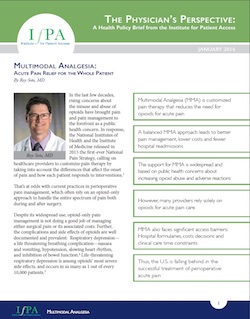by Amanda Conschafter, blog editor
A safer, more comprehensive approach to managing pain before, during and after surgery exists – yet not all patients can access it. So explains a new policy brief, “Multimodal Analgesia: Acute Pain Relief for the Whole Patient.” In the brief, the Institute for Patient Access examines what a multimodal approach to pain management entails and why patients and health care systems might benefit from its broader availability.

What is Multimodal Analgesia?
Authored by anesthesiologist Roy Soto, MD, the brief describes multimodal analgesia as “customized pain therapy” that can improve pain management, reduce costs and minimize hospital readmissions. The approach incorporates two or more treatments for pain management, including NSAIDS, acetaminophen, nerve blocks, opioids and other therapies or treatments.
Beyond Opioid-only Pain Management
Multimodal analgesia offers an alternative to opioid-only pain management, which can sometimes cause costly adverse events for patients. Obese patients, for instance, or those who smoke or suffer from sleep apnea can sometimes experience respiratory depression; thus, they carry a higher risk of mortality under an opioid-only approach.
And given widespread public concern about opioid abuse and misuse, components of multimodal analgesia such as IV acetaminophen can help to reduce patients’ need for opioids. IV acetaminophen often causes fewer of the side effects associated with opioid-only approach, such as nausea and vomiting, the paper explains.
Cost and Cost-savings
Using multiple medicines can be more expensive up front, particularly when compared to using only opioids in lower-cost, generic form. But the long-term cost savings associated with multimodal analgesia are compelling, the paper argues. A multimodal approach has been shown to reduce hospital stays by about a day, and a day’s hospital stay averages $2,000 nationwide.
Formulary Challenges
To keep decisions about pain management between patients and their health care providers, hospital formularies must include approved therapies for a multimodal approach. The paper suggests that this will require hospital formulary decisions to reflect long-term value – not just short-term cost. Making MMA more widely available will also require hospital formulary committees to encourage participation and welcome input from clinicians who treat patients for pain. Finally, the paper notes, training must shift to guide physicians on how to apply a multimodal approach for safer, more personalized pain management.
To learn more about patient access to multimodal analgesia for surgical pain, read “Multimodal Analgesia: Acute Pain Relief for the Whole Patient.”

